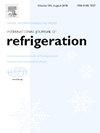An overview of selected “subzero” temperature storage regimes of foods: regulations and perspectives about the expected impact of the "three degrees of change" initiative on the shelf life of frozen foods
IF 3.5
2区 工程技术
Q1 ENGINEERING, MECHANICAL
International Journal of Refrigeration-revue Internationale Du Froid
Pub Date : 2025-04-17
DOI:10.1016/j.ijrefrig.2025.04.009
引用次数: 0
Abstract
Frozen storage temperature plays a crucial role in preserving the initial quality of frozen foods. The most used storage temperature of frozen food is -18°C and is based on 0°F, which corresponds to -17.8°C. This temperature does not correlate with a specific ratio of frozen water in foods (“level of frozenness"-LOF) and has been arbitrarily chosen. The fact is that at -18°C, most foods never reach a 100 % LOF (usually in the range of 95 % LOF). The 100 % LOF refers to a state in which the maximum ice crystallization zone has been covered (usually around -30°C). New low-temperature storage modes, such as chilling, superchilling, and supercooling, gained attention in academia and in the food industry, pushing the boundaries of existing regulations. The recent "Three Degrees if Change" initiative launched by the University of Birmingham (UK) aims at exploring the interest and impact of changing the frozen food storage temperature from -18°C to -15°C. This paper proposes a review of the current regulations in connection with selected subzero temperature storages. Based on the principle of the Q10 models, a Q3 model is proposed showing that frozen foods stored at -15°C may lose around 30 % of their quality life from the sensorial point of view. Raising the temperature to -15°C should not pose a major microbial risk; however, this point must be under scrutiny. In particular, the permitted temperature oscillations during transport and at the retail outlet may require some adjustment.
概述选定的“零度以下”食品储存制度:有关“三度变化”倡议对冷冻食品保质期的预期影响的法规和观点
冷冻贮藏温度对保持冷冻食品的初始质量起着至关重要的作用。冷冻食品最常用的储存温度是-18°C,以0°F为基础,对应-17.8°C。这个温度与食品中冷冻水的特定比例(“冷冻度”-LOF)无关,是任意选择的。事实是,在-18°C时,大多数食物永远不会达到100%的LOF(通常在95%的LOF范围内)。100% LOF是指最大冰结晶区被覆盖的状态(通常在-30°C左右)。新的低温储存方式,如冷冻、超冷冻和过冷却,在学术界和食品行业引起了关注,突破了现有法规的界限。最近,英国伯明翰大学发起了“三度变化”倡议,旨在探索将冷冻食品的储存温度从-18°C改为-15°C的兴趣和影响。本文提出了有关选择的零下温度储存的现行法规的审查。基于Q10模型的原理,提出了Q3模型,从感官的角度来看,储存在-15°C的冷冻食品可能会损失约30%的质量寿命。将温度提高到-15°C不会造成重大的微生物风险;然而,这一点必须加以审视。特别是,运输过程中和零售店允许的温度波动可能需要进行一些调整。
本文章由计算机程序翻译,如有差异,请以英文原文为准。
求助全文
约1分钟内获得全文
求助全文
来源期刊
CiteScore
7.30
自引率
12.80%
发文量
363
审稿时长
3.7 months
期刊介绍:
The International Journal of Refrigeration is published for the International Institute of Refrigeration (IIR) by Elsevier. It is essential reading for all those wishing to keep abreast of research and industrial news in refrigeration, air conditioning and associated fields. This is particularly important in these times of rapid introduction of alternative refrigerants and the emergence of new technology. The journal has published special issues on alternative refrigerants and novel topics in the field of boiling, condensation, heat pumps, food refrigeration, carbon dioxide, ammonia, hydrocarbons, magnetic refrigeration at room temperature, sorptive cooling, phase change materials and slurries, ejector technology, compressors, and solar cooling.
As well as original research papers the International Journal of Refrigeration also includes review articles, papers presented at IIR conferences, short reports and letters describing preliminary results and experimental details, and letters to the Editor on recent areas of discussion and controversy. Other features include forthcoming events, conference reports and book reviews.
Papers are published in either English or French with the IIR news section in both languages.

 求助内容:
求助内容: 应助结果提醒方式:
应助结果提醒方式:


